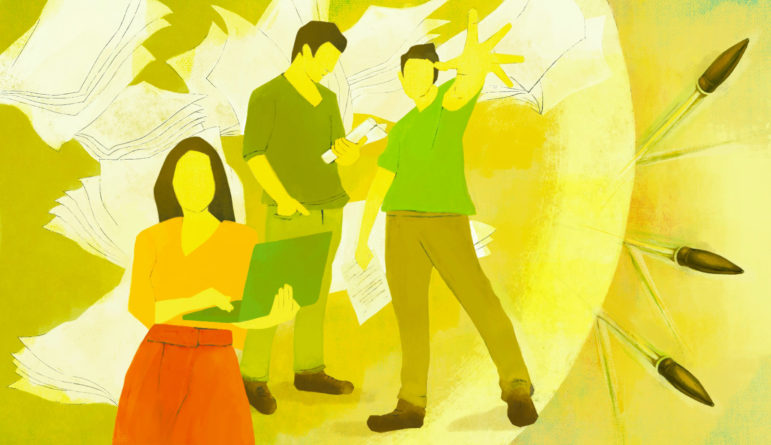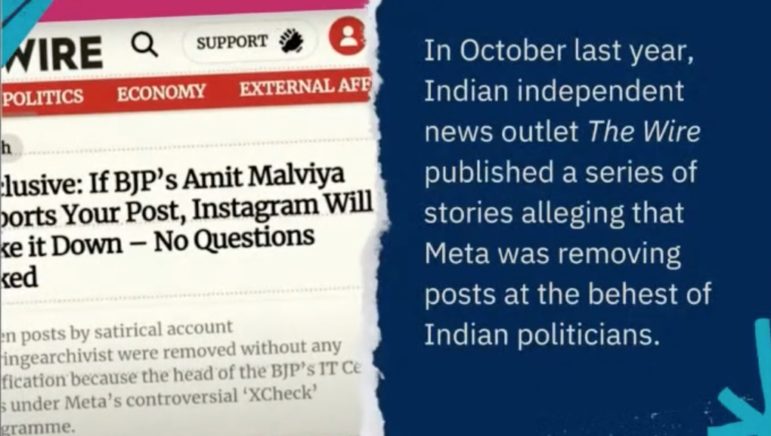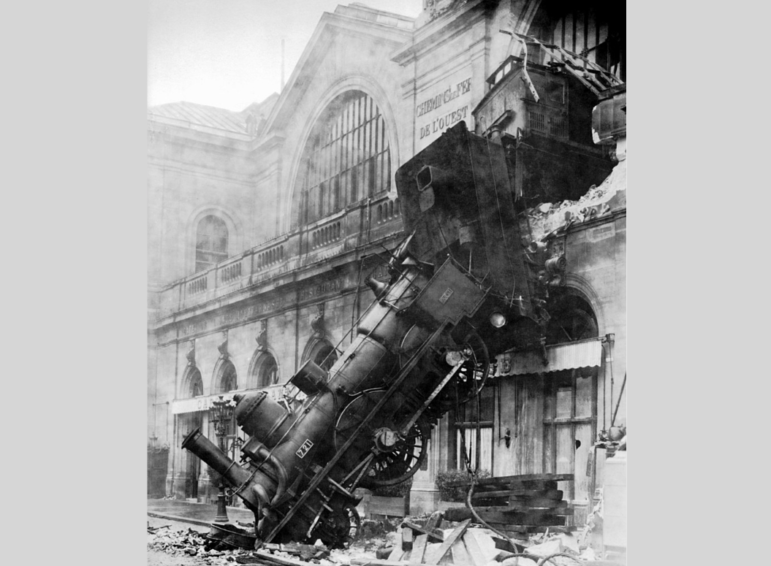

Image: Shutterstock
Navigating the Turbulence of an Editorial Crisis
Read this article in
Earlier this month, UK paper The Telegraph withdrew a story about the cost of school fee increases featuring an investment banker, claiming deceit by their source. The Press Gazette article on the story links to an earlier investigation that exposed a troubling trend of AI being used by bad faith actors to generate fake thought-leader profiles.
With disinformation rife and trust in the media at an all-time low, much has been said, written, and studied about how to regain and rebuild that trust. Little is said about navigating the storm of an ethical crisis.
“We do quite a lot of training when it comes to preparing for accidents, attacks, power outages, etc. But strangely enough, we do not prepare for editorial crises,” said Vibeke Fürst Haugen, director general of Norway’s public broadcaster, NRK.
The first woman to assume the title in 2022, Fürst Haugen faced a series of leadership challenges mere months into the role, culminating in a crisis that, she says, tops the list “of the most harrowing experience I’ve had in my professional life.”
In November 2023, NRK aired a documentary series about a troubled family, failing to mention a criminal offense committed 30 years ago, which led to a public uproar and its eventual depublication.
“There were several press ethical errors and omissions, and the series just didn’t live up to our journalistic standards. And since this mistake was so serious and painful, we chose to do a very honest and thorough postmortem assessment.”
Lapses in editorial judgement are fairly common, and publishers and news broadcasters often have to amend or even retract stories that fall short of ethical standards. But, noted Fürst Haugen, few take it further: to look systematically at how to resolve these issues before they arise.
“These kinds of crises have some characteristics in common. We have defined them as crises that occur when trust and reputation is threatened because of editorial or publishing decisions. These crises, they come creeping [up] on us.”
Fürst Haugen shared her experience — and NRK’s ongoing solutions — with participants at WAN-IFRA’s 76th World News Media Congress in Krakow in May.
The Missteps
“My feeling was that the crisis only grew the more facts we uncovered,” Fürst Haugen explained. “But it took time to get the information we needed to make such a drastic decision as depublishing this.”
- Serious editorial oversight, ethical errors, and omissions
- Time taken to respond
- Time taken to gain a comprehensive insight and correct
- Lack of internal support
“The worst part, I think, was that I did not have the necessary knowledge about the series, about what had happened when I heard about the series before it was published. I did not ask for more information. I should have. I knew our staff members were having a hard time, and I knew they wanted me to support them without reservation, and I couldn’t, again, because I didn’t have enough information.”
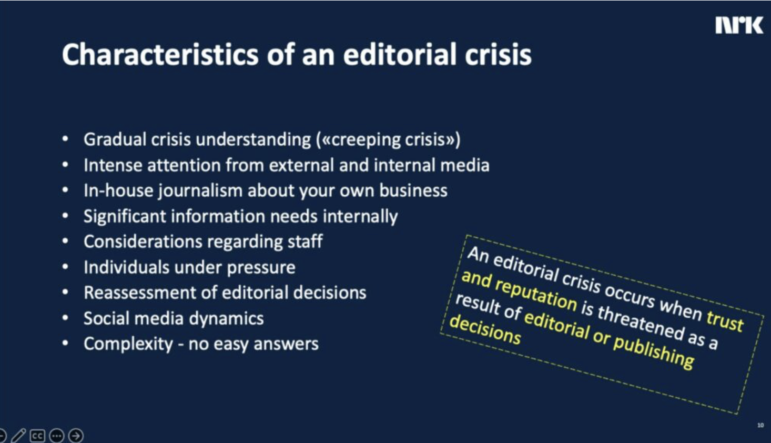
Image: Courtesy of NRK
The Lashback
“It’s top of the list of the most harrowing experiences I’ve had in my professional life, Fürst Haugen said. “During the culmination of this crisis, we received more than 100 media inquiries about the production and our handling of it. The media pressure against us felt quite monumental. We were criticized. Then we were criticised for taking too long to come forward and face the criticism.”
That experience was useful as well, she added.
“What we learned from this is that the biggest mistake we can make is not to make the mistakes; it is not to learn from it — and not to repeat it. We will make mistakes again, but I’m quite certain we’re not going to make the same mistake again.”
The Resolution
An honest postmortem assessment was conducted, and findings were shared widely to identify learning points rather than place blame. Four working groups were established to address areas for improvement and recommendations from these groups were largely implemented.
These four groups include a “Red Trail” — a guide with accompanying tools that strengthen the editorial line. A checklist, for example, can help assess whether an assignment should follow the red trail.
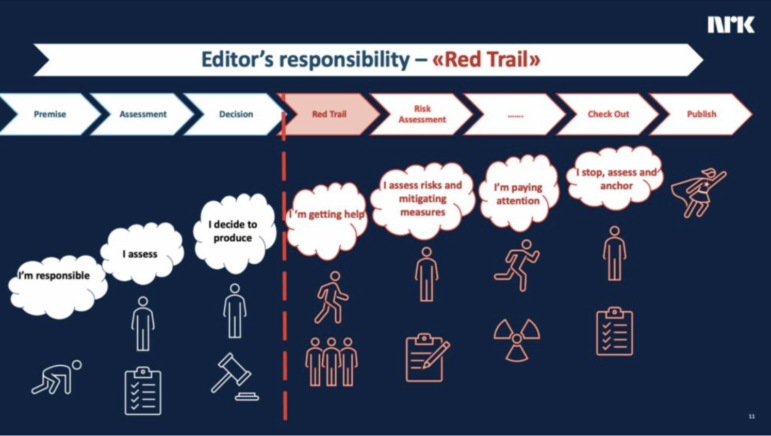
Image: Courtesy of NRK
Steps Taken
-
- Reorganising titles to create great clarity about responsibility and roles in the editorial hierarchy
- Greater awareness of press ethics throughout the organisation: Doubled central press ethics unit capacity from one to two people. “Press ethics has been included as one of our four prioritised areas of competencies; in 2025, it runs all the way through the organisation, from how we plan courses and learning programs, to the agenda of our meetings and our internal events.”
- Establishing new routines for reporting and handling concerns and crises internally.
- Established a system for low-scale crisis assessment that pushes the orange button, figuratively speaking, long before we push the big red button on The Red Trail.
- The crisis team has updated its plan for editorial crises and will quickly mobilise relevant professionals and managers depending on the crisis that has risen.
Painful as it was, the experience proved useful as well – which is why Fürst Haugen concluded her presentation with an industry-wide call to action, to adopt similar practices of honest assessment and proactive improvement.
This post was originally published on the WAN-IFRA site and is reprinted here with permission. It has been lightly edited for style and clarity.
Lucinda Jordaan is an independent media consultant with extensive experience in all media sectors and on all publishing platforms, from print and digital to film and broadcast. She has assumed various roles in her 30-year media career, from newsroom dash sub and freelance journalist to author and coach. She now freelances as a writer, editor, consultant and coach: providing full-suite media and communications services to media enterprises and agencies. Lucinda regularly writes for the WAN-IFRA World Editors Forum. A strong advocate for media literacy and development, she actively participates in various mentorships, training and skills development programs for young media aspirants and entrepreneurs.

